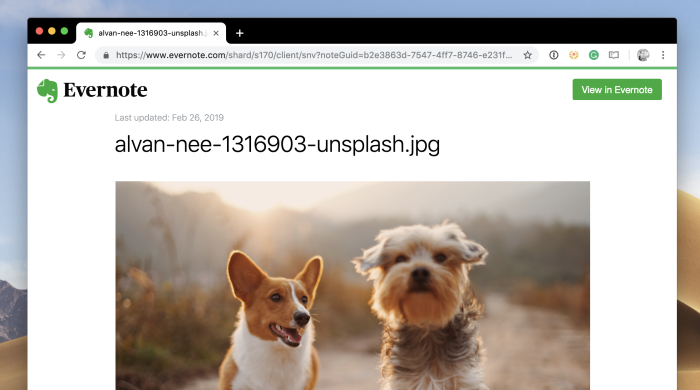- The new Evernote for iOS. Open the notebook and tap the options button (three dots). Tap Share notebook. Tap the permissions next to the invitee's name to change them. Older version of Evernote for iOS. Tap the menu button (three dots). Tap Share Notebook. Tap the pencil icon to.
- The salient portions here deal with the published and publishing attributes on the notebook. Published is a boolean that controls whether the notebook is publicly shared. To share a given notebook, set this value to true. Publishing is an instance of the Publishing type. At minimum, the uri attribute (which controls the ending portion of the sharing URL) must be defined for the notebook to be.
Authenticating with the Evernote Cloud API using OAuth Introduction. The OAuth flow is the a process a user goes through to authorize your application to access their Evernote account on their behalf. The user must approve access from an Evernote domain (www.evernote.com or sandbox.evernote.com). After approval is granted (or rejected) Evernote.
Note Links
Link directly to individual notes from anywhere


- Note Links
- In-App Note Links
- Public Links
Note Links are used to reference a note in a web browser that when the recipient of the link already has access via notebook or individual note sharing. In-App Note Links also known as ‘Classic Note Links’ are used to reference a note in Evernote clients like when notes are linked to from within other notes and to open notes in a Evernote client in situations were it is known that the user already has access to the note. Public Links are used to share a note with users who do not already have access though a web browser. Public links give access to view the note regardless of the share settings. The user can then save that note to their Evernote account. Public Links can be disabled by the user on a individual basis.
Before we dive into the structure of a link we should first take a look at the components of the links:
userID- the ID of the user, it should be stated that unless otherwise noted the user ID referenced below is that of the of the owner of that note. If you are only handling a single user's notes, this is simply the user id. The userId can be obtained by calling the getUser method on the userStore object and inspecting the id attribute of the resulting user object.
shardId - the ID of the shard the note is on. If you're dealing with a single user and their notes, this is the user's shard ID, eg 's29' or 's350”. The shardId can be obtained by calling the getUser method on the userStore object and inspecting the shardId attribute of the resulting user object. Please note that the shard ID will be different for business notes, notes that have been shared to the user, and notes from a notebook that has been shared with the user.
noteGuid - the GUID of the note being linked to. This can been obtained by inspecting the guid attribute of the note object you wish to share (note: you must call the createNote method on the note object before the guid attribute will be available).
Note Links
Note Links are used to reference a note in a browser when the recipient of the link already has access via notebook or individual note sharing.
Structure
https://[service]/shard/[shardId]/nl/[userId]/[noteGuid]/
Where:
Evernote Share Documents
- [service] is the name of the Evernote service (either sandbox.evernote.com or www.evernote.com)
- [userId] is the user ID of the notebook owner
- [shardId] is the shard ID where the note is stored
- [noteGuid] is the GUID of the note that is being linked to

Example:
Access is only granted if the recipient of the note link already has access to the note or to the notebook from which it is being shared. If the user is already logged into a Evernote account that has access to the note the note will open in the browser. If the user is not logged in they will be prompted to login to view the note:
Once the recipient has logged in the note will be opened in the browser (the note may also open in their Evernote client if they have enabled this feature the first time the recipient viewed a shared note via a Share Link).
If the recipient does not have access to the note the recipient is presented with the option to request permission to view the note:
This is useful when you know the recipient already has access to the note and do not wish to share the note publicly. Note links can be generated by the user by right clicking on a note and selecting “Copy Note Link”.
In-App Note Links
In-app links are used within the Evernote application to link to a note from within another notes. In-app Links can also induce the launching and subsequent opening of the desired note in an Evernote client from other applications. All note links start with “evernote:///“ Classic note links allow applications to reference a specific note within an Evernote client application. They can be used to link from one note to another or to allow easy access to a note from another context, such as a calendar invitation. Note links can reference a note, both synchronized and local, within a user's account as well as a note in a shared notebook that the user has read access to. It is important to note that classic note links will only work on a computer or device that has an up-to-date Evernote client application installed.
Structure
evernote:///view/[userId]/[shardId]/[noteGuid]/[noteGuid]/
Where:
- [userId] is the user id of the notebook owner
- [shardId] is the shard id of the notebook owner
- [noteGuid] is the guid of the note that is being linked to

Please note that the note GUID is listed at the end of the link twice, sequentially.
Examples:
or when embedded in HMTL or ENML:
If this link is opened in a browser it will open the Evernote application and if the note is present in the users account it will open that specific note. If the user does not have access to the note an error message from the Evernote application will appear informing the user that the note could not be found.
On Evernote Desktop clients (OS X and Windows) these links are generated when a note link is copied and pasted into another note and when a user right clicks on a note and holds down the alt or option key and selects “Copy Classic Note Link”.
Public Links are used to share a note with users who do not already have access to the note and is intended to open in a browser.
Structure:
https://[service]/shard/[shard ID]/sh/[noteGuid]/[shareKey]/
Evernote Share Notebook
Where:
- [service] is the name of the Evernote service (either sandbox.evernote.com or www.evernote.com)
- [shardId] is the shard ID where the note is stored
- [noteGuid] is the GUID of the note that is being linked to
- [shareKey] is the share key of the note. The shareKey is generated by calling the shareNote method on the noteStore object with the parameters authenticationToken and the guid of the note to be shared.
Examples:
This is useful when publish notes to external site outside your workspace like social media or a blog. Public links can be generated by the user by clicking on the button next to the “Share” button and selecting “Copy Public Link” in Evernote's desktop clients.
Evernote Shortened URLs
You may notice when copying links from within Evernote clients that the URLs do not take the form of any of those described above. Evernote has a URL shortening service built in to reduce the complexity and length of Evernote share URLs to allow for easier sharing. These shortened URLs automatically redirect to the note links described above. Currently there is no public API for the Evernote share URLs shortening service. Shortened URL take the form:
https://[service]/l/[random string]
Example:
